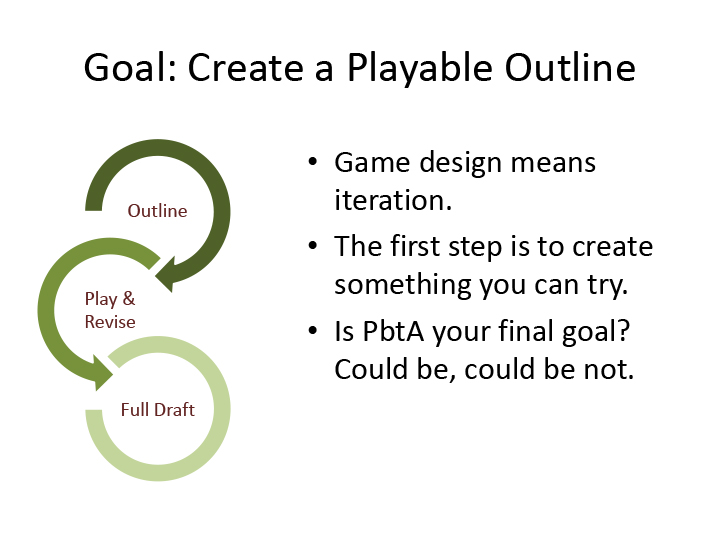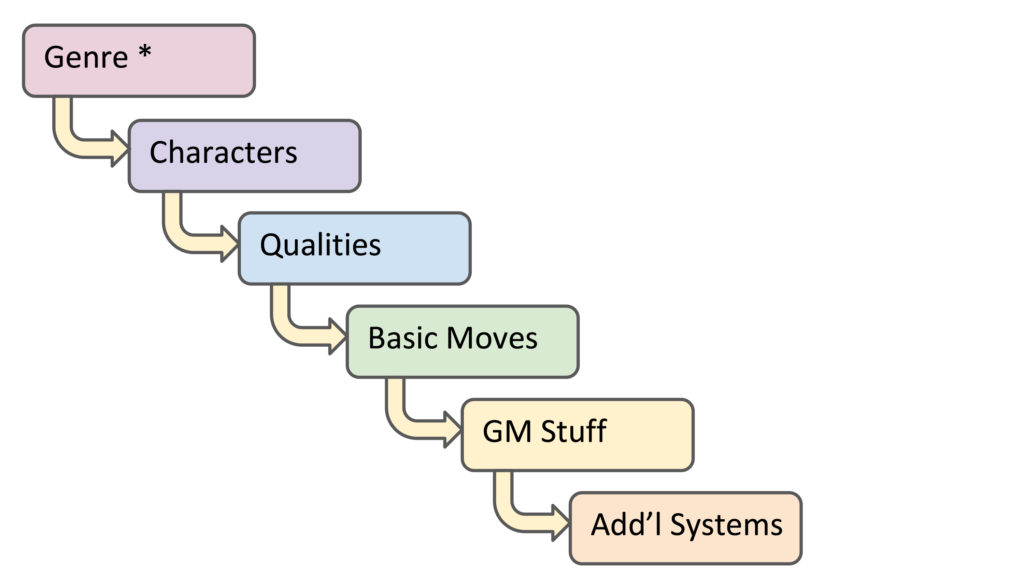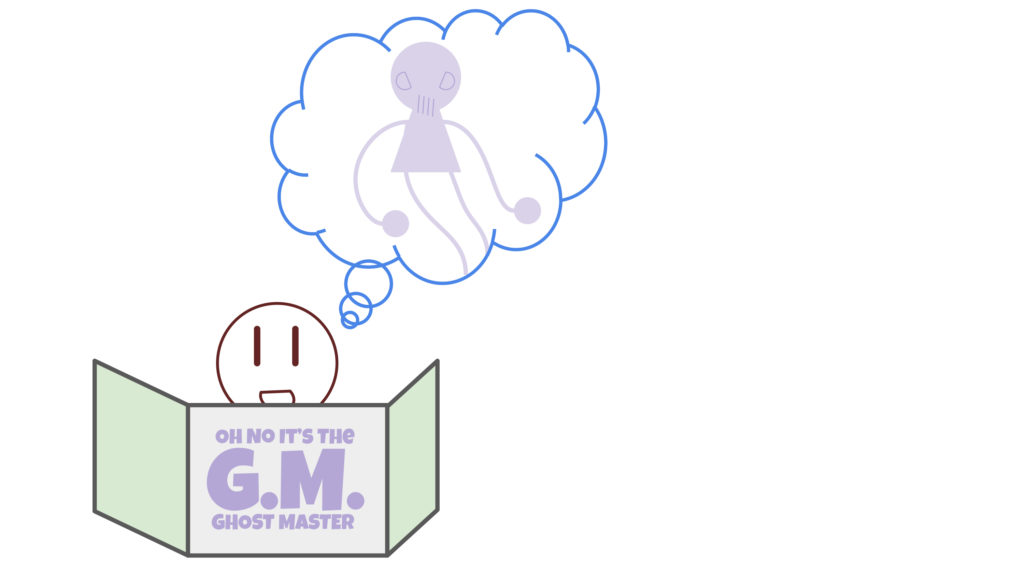Using Apocalypse World to Outline and Draft Your Own RPG
Here in Part 2, I’ll walk through the beginnings of taking Apocalypse World’s parts and using them as the basis for a whole new game.
This article was made possible by the generous support of my patrons. Please consider joining them by supporting me on Patreon.
This is adapted from a presentation I gave at Metatopia 2016. Pardon the PowerPointiness!
Here’s What
Apocalypse World offers a powerful, flexible framework you can use to outline, draft, and potentially finish your own roleplaying games. Dozens of creators, both experienced designers and first-timers, have used it with great success, and you can too. It’s not a game system as such, it’s an approach to game system design. It’s easy, and it’s a reliable way to get your creative vision quickly into a playable form.
Reminder: The Goal is to Create a Playable Outline

The process of game design for me is intensely iterative: a first stab, then play & revise, play & revise, play & revise. Eventually, after enough iterative cycles, I can make a full draft. Then comes more play and revision as I take the game public, and only once all of those cycles are done do I go on to finish the game for release.
So this series is about only that first goal: to make something you can try. The rest of the process, the vast bulk of the process, we’ll have to take up another time.
I want to emphasize and re-emphasize: maybe, at the end of the iterative process, you have a PbtA game, or maybe you set PbtA aside somewhere along the way and come out with something else altogether. That’s FANTASTIC.
My goal is to get you into the iterative cycle. Whatever comes out of it, is up to you.
A Process

Here’s the process I use.
1. Think of the game’s genre *
Or its mood, or feeling, or your vision for it. There’s something in your gut or behind your eyes that you want to explore, and for some reason, making a game is the way you’re going to explore it. That’s this.
* An aside on Genre: Come Out Swinging
I could get diverted for a week into talking about what genre is, does, and means, and what it isn’t, doesn’t do, and doesn’t mean. For now just this: genre gives you a backdrop of assumptions and conventions to build on and play against. It shorthands communication between you and your audience. But there’s no game in perfect adherence to genre formula. Your game’s take on its genre necessarily defies and confronts those assumptions and conventions. You might as well come out swinging!
2. Think of the game’s characters
This might mean making a 1st-draft list of playbooks, like Apocalypse World’s, but it might not. Playbooks are a useful way to organize characters when they have structural niches or substantial differences between them.
When your game’s characters are substantially similar — when they would, in effect, all have the same playbook — you don’t need to artificially create playbooks to differentiate them.
3. List the characters’ qualities
Your game’s characters’ basic qualities are the things that (a) all the characters have in common, that (b) you can use to compare them to each other.
In Apocalypse World they’re called “stats.” I say it like this: “in Apocalypse World, all the characters are cool, hard, hot, sharp, and weird, but some characters are cooler than others, some are harder than others, some are hotter…”
I don’t know how many your game needs. Probably 3–7. Possibly just 2. 1 is the same as none, which is also fine.
In Apocalypse World they’re adjectives (“both Dez and Smoky are hot, but Smoky’s way hotter”) but they can easily be nouns instead, like in D&D (“both Dezzor and Smoknar have wisdom, but Dezzor has way more wisdom”) or even adverbs, I suppose, if that’s what works for your game. Reserve verbs for the next step in the process, though.
4. List and begin drafting the basic moves
Your game’s basic moves are how the characters show their qualities. In Apocalypse World, the characters are cool, and they show this by acting under fire. They’re hard, and they show this by going aggro, by suckering people, and by going into battle.
It’s okay for the same quality to have more than one basic move. If you find a quality that has no basic moves, you might not need it, but hold onto it for now anyway. It might work perfectly with another non-move system later on.
Aside on the order of this process
Many designers who’ve used this process, including some who’ve had notable success, reverse steps 3 and 4: they list the basic moves first, and from them extrapolate the qualities that the characters must accordingly have. I do it in this order, where the characters’ qualities come first and the basic moves follow from them. Either way might work better for you!
5. Brainstorm the GM stuff
You need an agenda, rules (in Apocalypse World, “always say”), principles, and moves. When it comes time to finalize a working draft, you’ll come back and revise these, and you might find that you should then organize them differently: agenda and rules together under “job,” for instance, or rules and principles together under “duties,” or whatever arrangement makes sense for your game.
For now, for brainstorming purposes, stick with agenda, rules, principles, and moves.
6. Note and begin drafting additional systems
If you’re using playbooks or character moves to differentiate the characters, you’ll want to start listing those moves.
You probably already know some of the other additional systems you’ll need: a system for learning or character improvement, for instance, or a system for weapons and wounds, a system for spellcasting, a system for library research, a system for fighter plane dogfights, a system for the passage of generations, a GM-facing system for determining the movements of armies, or the goals and appetites of NPCs.
Every game needs its own assortment.
And then…
Once you’ve been through this process in outline, you can go back through, fill out what needs filling out, and draft up a 1st-time playable document. Bring it to the table to launch your game’s first iterative cycle.
A Working Example

1. Genre *
Let’s make a game about supernatural investigators, more like a ghost hunter type reality show than like say Ghostbusters. Working title “Oh No It’s Ghosts.”
Ghosts are real, but it’s legitimately difficult to communicate with them. They’re creatures of sorrow and anger, and might take any form or expression, might share in any other emotion or passion, that sorrow and anger can.
* Another aside on genre: It’s Futile
The only thing that can finally and fully communicate the vision inspiring you, the feeling in your gut, the thing behind your eyes, is your finished game itself. Meanwhile, when you try to talk to someone about what you’re working on — let alone collaborate! — you have to make do with incomplete, inadequate, sometimes actively misleading genre summaries. Like the one I just gave you. It’s futile but necessary, necessary but futile. Good luck to us all.
2. Characters
The characters in Oh No It’s Ghosts are all supernatural investigators. Let’s say that they’re historians, chaplains, sensitive souls, spiritualists, skeptics. It might be possible to create playbooks for these, but for now I think that they won’t need that kind of differentiation.
3. Qualities
The characters in Oh No It’s Ghosts are all brave, careful, insightful, patient, and sensitive. Maybe a historian is more careful and patient, and less brave; maybe a skeptic is more careful and brave, and less sensitive; maybe a spiritualist is more brave and sensitive, and less careful.
4. Basic Moves
We see how brave a character is when they stay put, or even push on, when frightening things are happening.
We see how careful a character is when they do research, conduct an interview, or set up an investigation.
We see how insightful a character is when they reflect on what they’ve learned, compare notes with their fellow investigators, or push someone in an interview.
We see how patient a character is when, like brave, they stick with something when it’s boring, repetitive, or unrewarding, instead of frightening.
We see how sensitive a character is when they listen to what a ghost is trying to tell them.
Now that I’ve got an initial list of basic moves, I’m going to start drafting some of them up. I’ll come back to step 5, the GM stuff, once I’ve got a bit of a handle on the basic moves.
Drafting Moves

Here are four versions of listen to what a ghost is trying to tell you. Compare them carefully!
Version 1:
When you listen to what a ghost is trying to tell you, roll and add your sensitive. On a 10+ hit, choose 2 of the following questions to ask the GM. The GM’s job is to answer them truthfully, but not to make their answers easy to understand. On a 7–9 hit, choose 1:
- What letter does the ghost’s name start with?
- What emotion is the ghost feeling?
- What’s something the ghost saw or experienced in life, that it still carries?
- Who does the ghost wish was here with us?
- What would the ghost do to me, if it could?
On a miss, choose 1 anyway, but then after the GM answers, tell the GM that something frightening happens. Ask them what it is.
Version 2:
When you listen to what a ghost is trying to tell you, roll and add your sensitive. On a 10+ hit, you hear what the ghost whispers; ask the GM what it is. On a 7–9 hit, instead, choose 1 and ask the GM to tell you what happens:
- You provoke the ghost to an extreme reaction.
- You feel the emotion that the ghost still carries.
- You can’t hear the ghost, but you do see it.
- The ghost directs your attention to something.
On a miss, tell the GM that something frightening happens. Ask them what it is.
Version 3:
When you listen to what a ghost is trying to tell you, roll and add your sensitive. On a 10+ hit, choose 1 of the following. On a 7–9 hit, the GM chooses 1 for you:
- The ghost whispers to you a detail of its life.
- The ghost whispers to you a detail of its death.
- The ghost whispers to you a detail of its loss.
- The ghost whispers to you a detail of its hatred.
- The ghost whispers to you a detail of its bondage.
- The ghost whispers to you about your own soul, or the soul of one of your friends.
On a miss, the ghost doesn’t whisper to you, but does something frightening instead.
Version 4:
When you listen to what a ghost is trying to tell you, first question the ghost aloud, then roll and add your sensitive. On a 10+ hit, the ghost answers you. Ask the GM what happens. The GM’s job is to have the ghost answer truthfully from its own point of view, according to its own experience, but not to make its answer easy to understand. On a 7–9 hit, the ghost answers you, or else answers a different question that you didn’t ask. Again, ask the GM what happens. On a miss, the ghost answers you, or doesn’t; something happens, or nothing. Ask the GM what you notice, if anything. What you make of it is up to you.
Permission & Expectations
These different versions of the move create different conversations between the players and the GM.
When you draft a move, you give the players (including the GM) permission and expectations. Permission to ask questions, with the expectation perhaps that they’ll be answered, or perhaps that they’ll be answered within a certain range, or perhaps that they won’t be answered. Permission to answer questions within a range, with the expectation perhaps that your answers will stand as given, or perhaps that they’ll be challenged, or perhaps that you can open them up for discussion instead. Permission and expectations both implicit and explicit, both immediate and far-reaching.
Stop Though

How do you choose which version to use?
How do you choose what permission to extend, what expectations to create?
How do you choose who to give power to, move by move, and what power to give them?
How do you choose who to provoke, and what to provoke them to do?
How do you choose whose consent to negotiate, and on what terms?
How do you choose who should defer, and to whom?
How do you create moves that build momentum?
The answer is…
What are You Playing to Find Out?

In Apocalypse World, we play the game to find out what the characters make of their world. What they want to make of it, and, because Apocalypse World is a game about compromise, what they’re able to make of it in fact.
How about in Oh No It’s Ghosts? What are we playing to find out?
There are several possibilities, all good, and before I can possibly decide between different versions of the basic moves, I need to commit to one. Let’s try some on.
- We play to find out whether the characters help the ghosts find peace, and which ones they can’t or won’t help.
- We play to find out whether the characters succumb to the ghosts or defeat them, believe the ghosts’ lies or see through them.
- We play to find out whether the characters can help the people who’re haunted by the ghosts, and if so, what it takes.
- We play to find out what the characters will do about their own selves, pasts, and souls, and whether they’ll leave life in peace or become ghosts themselves.
This is the direction of momentum in the game. A move builds momentum when it contributes to finding out.
So…
In Oh No It’s Ghosts, we play to find out: what’s the ghost’s deal, and what do the supernatural investigators do about it?
5. GM Stuff

When I’m working on a game, once I get serious and decide what we’re playing to find out, it always comes with wide-reaching clarity. Outlining the GM’s job at this point is almost as easy as listing out the characters’ qualities was. Given that we’re playing to find out this, what must the GM do?
In Oh No It’s Ghosts, your job as GM is to:
- Keep things believable.
- Make the ghosts sad and angry, and make it difficult to communicate with them.
- Discover your ghosts’ pasts as the investigators discover them.
- Don’t create solutions. Play to find out what the players’ characters are going to do.
Your rules are:
- Prep, and follow your prep.
- Give the players the full benefit of their moves and other resources.
- The players rely on you for what their characters see, hear, and experience, so in this regard at least, be reliable.
Your principles are something like:
- Make ghosts bring suffering to the living.
- Make the living helpless to control or mitigate the suffering ghosts bring them. Or, yknow, mostly helpless.
- Ground play in place, in history, and in personality.
- Ghosts want to survive, or they’d stop. Let your ghosts act for their own survival.
- Ghosts aren’t creatures of rationality. Give your gut reign, follow your own fear, and let your ghosts surprise even you.
If I were serious about this game, I’d want and need to include a principle about real trauma. I wouldn’t want to make a game about being haunted that wasn’t careful, thoughtful, and intentional about its position with regard to anxiety, depression, and PTSD.
And finally, your moves include things like:
- Have a haunted person do something desperate or misguided.
- Have a haunted person’s loved one do something desperate or misguided.
- Have a ghost reveal something about itself.
- Have a ghost reveal something about the person it’s haunting.
- Have a ghost act to tighten its grip on the person it’s haunting.
- Have a ghost make an overture to haunt someone new.
And surely others. Keep the list open and add to it as they occur to you.
6. Additional Systems
There are two big standout systems that Oh No It’s Ghosts needs:
- A system for prepping a ghost and the people it’s haunting. This system should create the haunting as a case, as it presents, as a complex of symptoms — but not nail down the ghost’s history, what’s the ghost’s deal. You discover the ghost’s history together in play.
- A system for dealing with ghosts, protecting people from them, mitigating the harm they cause, laying them to rest.
It also needs:
- A system or systems for research, interviews, and investigations, that fits well into the corresponding moves. I’m thinking about just a simple tag system, where a public library is good for different kinds of research than a local historical society or an internet chat group, for instance.
- Not much of a system for weapons, injuries, and healing, but a little bit of one. Maybe injuries should be life-threatening, serious, or not serious, so something along those lines.
- Either resources for the different characters to draw upon, like the historian’s access to research vs the spiritualist’s seance know-how vs the skeptic’s technology, or else character moves to accomplish the same.
- A system, I think, for the passage of weeks and months with no breakthroughs and no definite developments. How the haunting proceeds when nothing’s doing.
From Outline to Draft
What we have here is a solid outline.
The next step is to flesh it out into a playable draft:
- Initial versions of all the basic moves.
- A process for character creation.
- A first stab at the additional systems, especially the GM’s system for creating hauntings. That’ll take a little work.
Then it’s to the table to see how it works, and we’re in the iterative cycle!
The first time I brought Apocalypse World to the table, I had four or five draft playbooks, an early version of the basic moves, an early version of the harm rules, and a few notebook pages about how I intended to GM it. I hadn’t even hit upon agenda-rules-principles-moves yet, I just had disorganized notes. You’ll be okay.
Play early and revise often!

Next Up, in Part 3
In Part 3, I’ll dive back into Apocalypse World’s basic moves. I’ll go through them one by one to talk about how and why they work the way they do.
Here’s a preview:

Thanks for reading!
Past Installment:
- Back in Part 1, I laid out Apocalypse World’s philosophy and foundation, described the fit and purpose of its systems, and talked about which features are central to its workings and which aren’t.
Next Installments:
- In Part 3, I dive back into Apocalypse World’s basic moves. I go through them one by one to talk about how and why they work the way they do.
- In Part 4, I talk about playbooks, by request. What are they, do you want them in your game, and what are the alternatives?
- In Part 5, I take a quick aside to talk about some different ways that moves can fit into the conversation of play.
- In Part 6, I use an Ursula K. LeGuin quote — you probably already know the one — as an outline for alternative models to Apocalypse World’s model of conflict.
- Part 7’s a good old-fashioned Q&A, in rounds: Round 1, Round 2, Round 3 (the lightning round!), & Q&A Round 4 (the Final Round!)
- In Part 8, I share my six best, most reliable tricks for drafting interesting moves.
- In Part 9, I lay some groundwork for the idea of underlying models by pointing out a crucial feature of Apocalypse World.
- In Part 10, I develop the idea of underlying models further, with 2 solid examples and 1 tentative one.
- In Part 11, I explore a few of the dice systems we’ve used in our PbtA games.
- In Part 12, I point out a detail in Apocalypse World’s playbook moves that you might have missed.

dontnormally says:
One thing I’d love to see at some point during this series is a swing at making playbooks. I recognize they’re potentially overused by folks who hack your system but I think it’s for good reason; they’re neat, easily understandable, and usable.
Thanks for putting these posts together!
Using Apocalypse World to Outline and Draft Your Own RPG | antiknez says:
[…] Baker wrote a comprehensive and useful guide to using the Apocalypse World framework to move you through a game design process. It’s a […]
Noah says:
I hope we don’t have to wait 2 months for the next one, cuz these are _very_ interesting!
Vincent Baker says:
No promises!
Sam says:
Some thoughts, some of them related to my comment on the last post:
First, I think I was onto something about a certain degree of minimalism implicit to this approach. I think that’s a natural consequence of some parts of the process sketched here, even if it’s not an explicit aim or something you consider core to PbtA. For example, when you design the qualities, you look for the things the characters have in common that vary between them, and you end up with a pretty limited set. One could easily imagine enumerating far more qualities, right? And in your example, you mostly have just one move each (or one idea for a move) that expresses each of the qualities. There might be a few more for some qualities, and you do usually see a little quality overlap in the basic moves of most PbtA games, but PbtA games on the whole really do tend to have about one basic move per quality, and it’s interesting to me that your process here reflects that. This seems distinguishing too: most PbtA games seem a lot closer to one another in this regard than how close they are in this respect to, say, how many skills key off of each attribute in most skill-and-attribute games. It’s also pretty different from games that use the attributes directly, with catch-all “attribute checks” – those might technically be fewer in number, strictly one-per-attribute, but they’re often applicable over a much wider range, so in a significant sense less minimal.
I think it’s also visible in the way you phrase some things, like “for now I think that they won’t need that kind of differentiation”. There’s definitely an idea about what is “needed” here, and even with the same notion of “needed”, one could imagine a very different perspective where you put them in even if they aren’t “needed”. And I think this perspective is also a distinguishing factor of most PbtA games, and the PbtA approach to game design you’re articulating in this series: design is about including what is needed.
One other core thing that strikes me as unique, common across a lot of PbtA, and part of your design here, is the notion that “the thing the game is about” should be fundamentally unknown in a sense. You ought to know what kind of thing it is, but the game should generate the particulars. This may not be totally unique to PbtA, and I think maybe I’ve grasped the edges of that idea in directives to “play to find out what happens”, but I like how clear it is here, and I think it’s definitely a feature that sets the PbtA approach apart.
You might say “that’s what all games are about – whatever particulars it is they’re focused on generating”, and maybe that’s true, but many games definitely aren’t designed from that perspective.
I might conceive of the idea here as: there’s a hole at the center of what I’m designing, a gap that is unfilled when players first sit down, that playing the game will fill, and the design of the game should (1) flow towards that hole, filling it, and (2) make sure the hole is where I want it – that the space is really empty, that the hole is positioned to reflect a question that I’m interested in seeing answered, and that the answer is more interesting to generate indirectly and collaboratively than to just answer myself.
I think a lot of games approach design from the opposite side: they don’t focus on the hole, but on the solid parts around it. They conceive of the hole is a side effect – maybe they recognize its primacy in gameplay, but they don’t in their design efforts. They conceive of the game’s design as being “about” the concrete stuff, not the empty part the game is going to fill in. If you want the game to be about badass martial arts moves, you don’t think of that as the hole that the game will fill, as an open question, you create badass martial arts moves for the players to use, and if that leads to a hole/question like “how do the characters show what badass martial artists they are?”, that’s obviously a positive outcome of the design, and maybe even a predictable one – this design process doesn’t just create holes at random – but it’s still different from starting with/focusing on that hole and building the scaffolding around it.
Vincent Baker says:
Astute! I think I agree with you, top to bottom.
Brett Maack says:
Not sure if you’re still monitoring the comments on these wonderful posts, but I have a question.
Can a game try to ask more than one ”Play to find out _____” question? More specifically, could Oh No It’s Ghosts ask both:
“We play to find out whether the characters help the ghosts find peace, and which ones they can’t or won’t help.”
and
“We play to find out what the characters will do about their own selves, pasts, and souls, and whether they’ll leave life in peace or become ghosts themselves.”
My first thought is that the answer is yes. Unless I’m mistaken, games that have different phases of play (i.e. Blades in the Dark’s Heist Phase vs Downtime Phase) achieve this by asking one question during one phase and a different question in a different phase.
So for Oh No It’s Ghosts, there would be moves for “The Case Phase” that players use to play and find out if the ghosts find peace. Then, in downtime, moves would exist to help the playgroup determine their characters’ respective fates.
Am I on the right track here, or am I thinking too small? Perhaps it would create a tighter design to have any alternate game phases continue to guide play towards the same questions. Or perhaps trying to ask two questions just creates a compound question like this:
“We play to find out the fates of both spirits and the mortals who seek them; both peaceful rest and desperate haunt are found in the interplay of histories, actions, consequences, and peoples along the way”
Alejandro says:
I guess he’s no longer monitoring these. I had the same question.
Vincent Baker says:
Oh! My answer is, sure.
Nico says:
I know we’ve moved on from here, and it may be neither here nor there, but one thing that’s always tripped me up is the relationship between agendas, rules and principles (or the GM’s jobs, principles and what to always say, or whatever names and schemes the game in question calls for).
Sometimes, and this is just my brain, I look at a list of bullets and I don’t know what shape to hold them in in my mind. What makes one an agenda, one a rule, and one a principle, and how do they work together? How loose or tight are those distinctions and relationships, and how should I think of them and use them in design and in play?
Vincent Baker says:
To me, they’re schemes for presenting the ideas, more than anything else. Your game has a complex of ideas it needs to communicate, but as ideas, they’re all interrelated and interdependent, they don’t necessarily fall into any natural hierarchy.
So nothing makes one an agenda, one a rule, and one a principle. If you decide to present them that way, it’s hopefully to help your reader make sense of them.
naught101 says:
I’ve just started reading this series in the last few days, and am absolutely loving it. It already has me on my way to fleshing out a game idea I’ve had for a while (my first serious attempt, I think). The series makes it feel very achievable.
Since you’re starting to add more posts to it again, I thought I’d throw in a request for a bit of expansion on the last point in this post – 6. Additional Systems. I’d love to hear your thoughts on how to decide when to use a mechanical system vs leaving it to the narrative, and how to think about designing those systems (e.g. what approaches are most appropriate for a given need, what considerations are important).